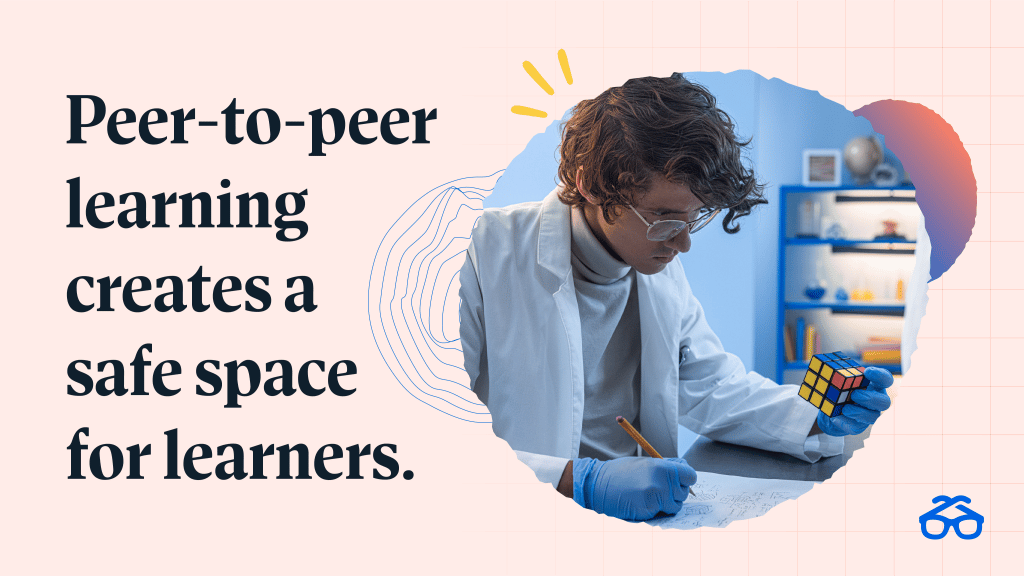Many of us in the learning industry spend our time trying to uncover the most effective methods for skill building. We spend hours researching and trying new products. But one of the best resources for establishing learning can often come from your most prevalent resource — your employees. Peer-to-peer learning can be one of the most powerful and employee-preferred methods for deep learning.
In a 2021 report from Degreed, we found more people preferred to learn from their peers, teammates or professional network than any other source. Yet most organizations do not have an effective way to promote, encourage and provide time for people to learn from their peers.

Empowering Conversations & Relationships
When I was the Chief Learning Officer at LinkedIn, my team created a learning program called Conscious Business, which focused on building what I call Power Skills. One of those power skills was having difficult conversations. One problem we were trying to solve was that people didn’t feel like they had time for learning, so we designed a four-week, cohort-based, mostly asynchronous peer-to-peer online learning program that required only a one-hour live session per week.
Each week, the learning cohort started with a video overview of that week’s topic followed by a discussion question. Then, participants were given an assignment to practice the skill with one person in their peer group and then practice the skill in a real-world situation. At the end of the week, the group joined a live one-hour video session, and a facilitator led the group in a discussion.

One of the participants, John, brought an example of a difficult conversation he had had with Mark, one of his teammates. John confronted Mark about some missed deadlines that were negatively impacting their entire team. Mark became defensive and John left the conversation feeling awkward, uncomfortable and with little to show for it.
John brought up the conversation in that week’s peer learning group, and many in the group nodded their heads. They too had recently had similar situations and conversations. By discussing this with a group of peers, John and the other participants began to reflect and learn from each other. New tactics and techniques on how to better handle real-world difficult conversations came to light. People left the learning session feeling revitalized and empowered.
The Conscious Business program became one of the most popular learning programs at LinkedIn, and employees enjoyed the added benefit of building relationships at work. In the online discussion section of the learning platform, participants continued to share their experiences with their peers. In doing so, they continued to not only get feedback but to feel more confident and productive conducting difficult conversations during and after the peer-to-peer learning program concluded.
The Benefits of Peer Learning
When given a safe space to connect, people are more likely to feel comfortable sharing their real-world experiences, admit their faults and failures and practice deep listening. And it’s just more fun to collaborate and learn with co-workers than it is to sit alone and listen to yet another training video. Yes, mentors and coaches provide excellent collaborative learning opportunities, but the power dynamics of the relationship can sometimes stifle deep learning. With peers providing the learning in a safe space, people are more open to feedback and growth.
When you place enough trust in your people for them to teach each other, you support a positive workplace culture — one in which people feel respected, connected and heard. You show your employees your organization values their expertise and experiences. And you help them form stronger bonds as they bridge divides between generations and teams.
How to Set Up a Peer-to-Peer Learning Program
A peer-to-peer learning program can be set up in many ways. Managers can create cohorts. L&D departments can set up small groups. And department heads can encourage peer one-on-one meetings. Timing is important. A successful program cannot be run in one day. Peer learning works best when it’s carried out over weeks or months with an emphasis on open reflection and feedback.
If you’re thinking of creating your own peer-to-peer learning program, five steps are key:
- Organize the group(s). For the peer part of the learning to happen, everyone in the group should be on an equal seniority level. At LinkedIn, we experimented with including people from different parts of the company and people working on the same project. Both approaches were effective.
- Designate a facilitator. The preferred facilitator is an external, impartial and trained individual who can guide discussions, synthesize information and keep the conversation on track.
- Establish psychological safety. A comfortable physical environment, whether online or in-person, is required for successful learning. The space should be free of distractions and private, so conversations are not overheard. The facilitator should lay out the rules of engagement, including no tolerance for bullying, unnecessary negativity or hate speech. It’s imperative people feel they can honestly and openly share feedback and real-life situations.
- Include real-world experiences and scenarios. True-to-life issues and experiences elicit a stronger emotional connection and more engagement, providing much deeper skill building than scripted scenarios.
- Create networking and collaboration opportunities. Online or in-person meetings for those involved in the program to discuss their area of expertise and ideas help deepen the connection between peers and encourage learning. For some companies, this could be a learning week that includes employees teaching others. Or it could be as simple as engineers getting together for tech talks sharing their latest projects and getting feedback.
I’ve found peer-to-peer learning to be a powerful learning method. With the Conscious Business program, it turned out to be an effective model for learning important and valuable skills and building solid, ongoing relationships. Given the importance of building skills for the future, and amid the increasing prevalence of capability academies, peer-to-peer learning can be a valuable addition to your learning and development programs.
